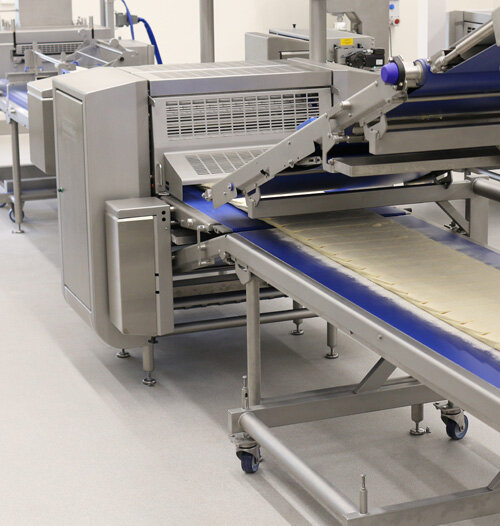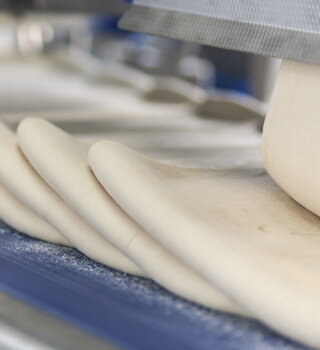The sweet taste of laminated treats
Close your eyes and visualize a small bakery. Smell the delightful aromas of croissants and exquisite pastries. Wouldn’t you love to produce such treats yourself?
The secret to high-quality pastry and croissant products lies in lamination. This process can also be used for the production of bread products and pizzas. Traditional lamination involves rolling out the dough and adding a continuous layer of fat, which is folded into the dough sheet. The folded dough sheet is then repeatedly laminated and rolled out to build the required number of dough and fat layers. Rademaker leverages its experience in rolling technology to develop innovative, stress-free dough rolling and processing processes that can handle a wide range of dough, butter, and fat types. Laminated dough can be produced using the All-In method and the French method. Market-oriented research and development form the basis of the three different lamination methods that Rademaker has developed (overlapping, retracting, and cutting & stacking). The best method for your application depends on the required capacity and the type of dough being used.

Laminated dough consists of multiple layers of dough separated by thin layers of fat, such as margarine or butter. These layers create a flaky texture. The formation of this flaky structure occurs during the baking process when the water in the dough is converted into steam. This process causes the dough layers to expand.
The Scottish Method, also known as the Dutch, All-in, or Blitz method, involves cutting the fat into cubes and adding it to the other ingredients. After mixing/kneading, the dough is rolled out into a sheet and laminated.
The French Method
In this method, a sheet of dough is produced, after which a layer of fat is added to the dough sheet and folded into the dough to form two layers of dough and one layer of fat.

Dough type
The number of layers is related to the type of dough you want to produce:
- Croissant dough with yeast, consisting of, for example, 16 layers. The fewer the layers, the more open the structure of the baked product.
- Danish dough, or in German, “Plunderteig.” Yeast dough with often a higher fat content than croissant dough. An example in this category is the Danish “Spandauer.”
- Puff pastry, or in German, “Blätterteig,” made from yeast-free dough, typically consists of 64 to 100 layers (on an industrial laminator), resulting in a fine structure with a lower volume per layer. A mille-feuille, which means “a thousand sheets,” is a product in this category.
In general, the lower the number of layers, the more open the structure.
Three Lamination Methods:
Discover Rademaker’s expertise in dough lamination with our three innovative methods, each designed to meet your specific needs and dough types. Whether you are producing croissants, puff pastry, or Danish pastries, we have the solution for you. Additionally, our inline lamination option offers unparalleled flexibility with widths up to 1600 mm.
Overlapping (Lapping)
- Ideal for small surfaces due to its compact design
- Provides a cost-effective solution
- Can create 4-12 layers with a maximum width of 600 mm
- A symmetrical method suitable for various dough types
Horizontal Laminating
- Delivers high speed with a wide range of lamination widths
- Suitable for soft dough without width limitations
- Enables efficient production of 4-12 layers with widths ranging from 600 to 1600 mm
Cutting and Stacking
- Ensures precise layer buildup with options for 3-12 layers
- Provides the best consistency and high-quality results
- Offers flexibility for both even and uneven layer buildup, perfect for soft dough
- Supports widths from 600 to 1600 mm, tailored to diverse production needs
Choose Rademaker for advanced lamination methods that optimize efficiency and quality, allowing your products to stand out in the market.
our laminators
Rademaker has 2 laminators that are capable of processing 250 kg up to 10,000 kg dough per hour.

Radini
- Suitable for various dough types
- From 250 kg to 1,000 kg of dough per hour
- Up to 24 layers per section
- Working width: 600 or 800 mm
- No risk of fat extraction

- Suitable for various dough types
- From 500 kg to 10,000 kg of dough per hour
- Up to 512 layers
- Working width: 600, 800, 1,000, and 1,200 mm
- Optional: Working width greater than
Contact Us
Ready to automate your production? Learn more and get in touch by phone, email, or by using our contact form
